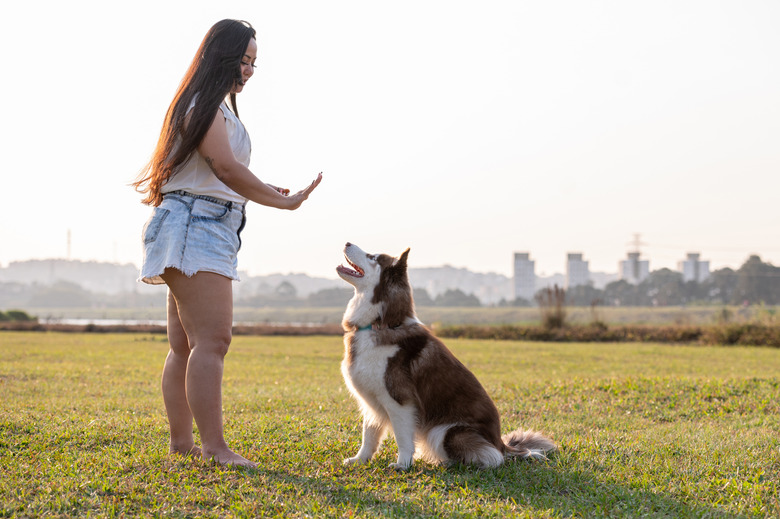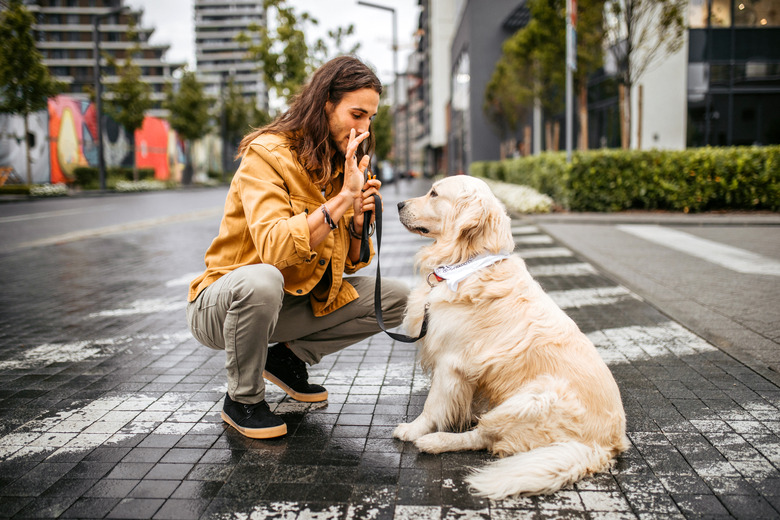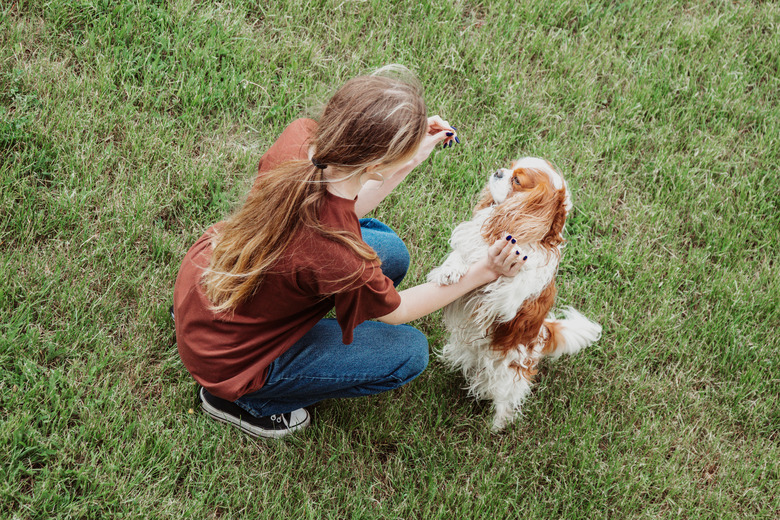Teaching A Dog To "Stay" In The Real World
Teaching your dog how to "stay" while being outdoors can be a fun bonding experience for you and your dog. Learning this cue also helps keep them safe. Yet, teaching your dog to "stay" in a high distraction environment can also be difficult. This can include other dogs, squirrels, and people. Though with time and patience, you can teach your dog to ignore distractions — and how to "stay" in the real world.
Be slow and intentional with your dog training plan
Be slow and intentional with your dog training plan
Knowing how to stay on cue is important for all dogs to know. When teaching the stay cue, many dog owners will often move too quickly. Some will teach the skill to their dog for the first time while at a dog park. Or in another distracting environment.
Instead, start by teaching your dog to stay in your home or another low-distraction environment. This will help your dog be able to focus while they are learning the skill. Be slow and intentional with your training plan, to help your dog be successful. After your dog successfully understands how to "stay" in your house, transition to higher distraction areas.
1. Pick verbal and physical cues and slowly introduce them to your dog
First, ask your dog to sit or say, "down." Give your verbal cue of choice like "wait" or "stay" together with a hand signal of your choice. Most people choose to use a flat palm towards their dog. Then, immediately praise and click, if you are clicker training. Release your dog with a verbal release cue such as, "ok" or "free". Then, toss a dog treat for them. At this point, your dog doesn't understand these words. But, you're going to slowly build on their understanding of these cues.
2. Slowly increase and build the duration your dog stays when cued
In the next sessions, ask your dog to stay and then wait a fraction of a second longer. You should do this before giving your release cue and tossing a treat. Keep in mind that building a solid and consistent stay cue in the real world requires a lot of patience — especially in the beginning. Try not to get impatient or rush the process. Going slowly will result in a stronger and more consistent cue for your dog in the long term.
3. Begin to increase the length of time you ask your dog to stay
Slowly build up the difficulty by increasing the amount of time you ask your dog to stay during the training. You can also treat and release your dog (instead of tossing treats) as your dog builds their understanding of the "stay" and "release" cues. At this stage, you can also slowly start to increase the distraction levels. Begin by tossing toys or treats while your dog is in a stay position. Remind your dog to "leave" the treat if they already know that cue. Remind them before tossing the toy or treat for them to then ignore.
4. Proof your dog's understanding of the stay cue over time
As your dog gets more experienced, you'll want to start "proofing" their behavior. This means increasing the difficulty of the behavior you are asking from them — slowly and intentionally. You will want to continue working on this stay cue in low distraction environments until your dog is secure. Stay close to your dog and ask them to hold the stay for a shorter period of time. Keep in mind that the goal of this should be to keep your dog on a successful path. It should not be to test how long you can ask your dog to stay on cue — especially when distractions are present.
5. Transition your dog to work on the stay cue together in the real world
When your dog can successfully hold a stay cue in a low distracting environment, it's time to take your work to a park or other crowded area. Start with "staying" in your front yard or in a quiet area outdoors. Then, start to work on the skill in crowded areas. Build up the distraction and difficulty levels slowly. As the distractions increase, ask your dog to stay for a shorter length of time than you would have in the previous steps.
Be consistent and use positive reinforcement while dog training
Be consistent and use positive reinforcement while dog training
As you're teaching your dog to stay, be clear with yourself about your criteria for the training. For example, are you expecting your dog to hold a sit-stay position? Or do you want your dog to stay in a general area, as like a dog bed? There's no right or wrong answer about your "stay" criteria. Though you want to be clear about it for yourself, so you can make it clear to your dog. Dogs thrive on clear expectations. When the criteria shift, it can make it hard for dogs to know what they should be doing and what is being asked of them.
You always want to utilize positive reinforcement methods when teaching stay cues. If your dog "breaks" their stay or doesn't stay when you cue them do not correct them. This is a moment for you to gather information and learn from your dog. It could be that what you were asking was more complicated than what your dog could do in that given moment or location. Take in that information for the future. Create training setups that raise the difficulty more slowly — so your dog can be successful.
Seek out professional dog training support
Seek out professional dog training support
If your dog is struggling with behavior issues while learning their cues or during basic training, it's always helpful to get professional support. Look for a Certified Professional Dog Trainer (CPDT-KA) in your local area who utilizes positive reinforcement training techniques. They can even help you with a new puppy or an older dog.
In summary
In summary
Teaching your dog how to stay is an essential skill that all dogs should know. Though teaching a reliable stay cue requires patience. Rushing the process by asking for too much, too quickly can burn a dog out. Going too fast can also leave them confused about what behavior you want from them. Instead, slowly increase the difficulty of what you're asking from them. Start by teaching your dog how to "stay" in low distraction environments. Then, build up to those more distracting real-world locations.



